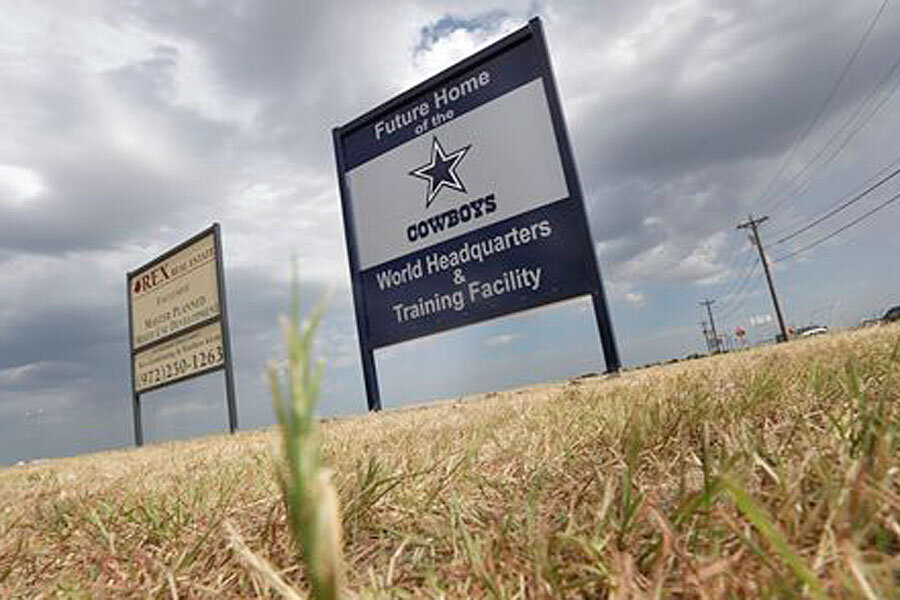Texas leads list of fastest growing US cities
Loading...
| Washington
They grow everything bigger in Texas, even the cities.
Three of the nation's five fastest-growing cities — and seven of the top 15 — are located in the Lone Star State, new data from the Census Bureau shows. The Texas cities of San Marcos, Frisco and Cedar Park were No. 1, 2 and 4 in percentage population growth between 2012 and 2013, each growing by at least 5 percent in that time span.
Utah had two of the top five: South Jordan, at No. 3, and Lehi, at No. 5.
This is the second year in a row that San Marcos, centrally located between Austin and San Antonio on Interstate 35, has topped the list of fastest-growing cities with a population of more than 50,000. Its population grew by 8 percent between July 2012 and 2013 to 54,076 people.
That's well ahead of its 2011-12 increase of 4.9 percent, which pushed San Marcos into the upper echelon of cities with 50,000-plus people.
Mayor Daniel Guerrero, in Chicago recruiting business investment for his city, said that in addition to its enviable location between Austin and San Antonio, San Marcos has one of the nation's largest outlet malls and is home of the 35,000-student Texas State University.
"We have an immaculate natural beauty to our community, certainly the spring-fed river ... San Marcos River... historic neighborhoods, a growing and beautified downtown that we've been investing in heavily over the last few years," Guerrero said. The presence and growth of the university is also a factor, he said.
The West is in the middle of a population boom, with energy production one of the fastest-growing industries in the United States. The oil- and gas-rich fields of the Great Plains and Mountain West have fueled the population increase. The majority of the fastest-growing cities are west of the Mississippi River.
The 15 top cities by percentage increase were San Marcos, Texas, 8 percent; Frisco, Texas, 6.5 percent; South Jordan, Utah, 6.1 percent; Cedar Park, Texas, 5.6 percent; Lehi, Utah, 5.5 percent; Goodyear, Arizona, 4.8 percent; Georgetown, Texas, 4.5 percent; Gaithersburg, Maryland, 4.4 percent; Mount Pleasant, South Carolina, 4.1 percent; Meridian, Idaho, 4.0 percent; Odessa, Texas, 4.0 percent; Gilbert, Arizona, 4.0 percent; McKinney, Texas, 3.9 percent; Franklin, Tennessee, 3.9 percent; and Pearland, Texas, 3.8 percent.
By population increase, New York City is still on top, growing by 61,440 people in 2012 to 8.4 million people in 2013. In addition to having the largest numerical increase, New York City is also still the largest city in the United States by population.
Houston increased by 35,202 people to 2.2 million in 2013. Los Angeles grew by 31,525 to 3.8 million.
The rest of the top 10 by numerical increase were: San Antonio, up 25,378 to 1.4 million; Phoenix, up 24,843 to 1.5 million; Austin, Texas, up 20,993 to 885,400: San Diego, up 18,867 to 1.35 million; Charlotte, North Carolina, up 18,420 to 792,862; Seattle, up 17,770 to 652,405; and Dallas, up 15,976 to 1.3 million.
The Census Bureau also said:
— Fourteen cities joined the 50,000-plus population club: Casa Grande and Aliso Viejo, Arizona; Dublin and Palm Desert, California; Doral, Florida; Huntersville, North Carolina; Enid, Oklahoma; Grapevine, Texas; Ankeny, Iowa; Lenexa, Kansas; Kentwood, Michigan; Apple Valley, Minnesota; Tigard, Oregon; and Sammamish, Washington.
— No cities with more than 50,000 people dropped below that level between 2012 and 2013.
___
Follow Jesse J. Holland on Twitter at http://www.twitter.com/jessejholland
Copyright 2014 The Associated Press. All rights reserved. This material may not be published, broadcast, rewritten or redistributed.





